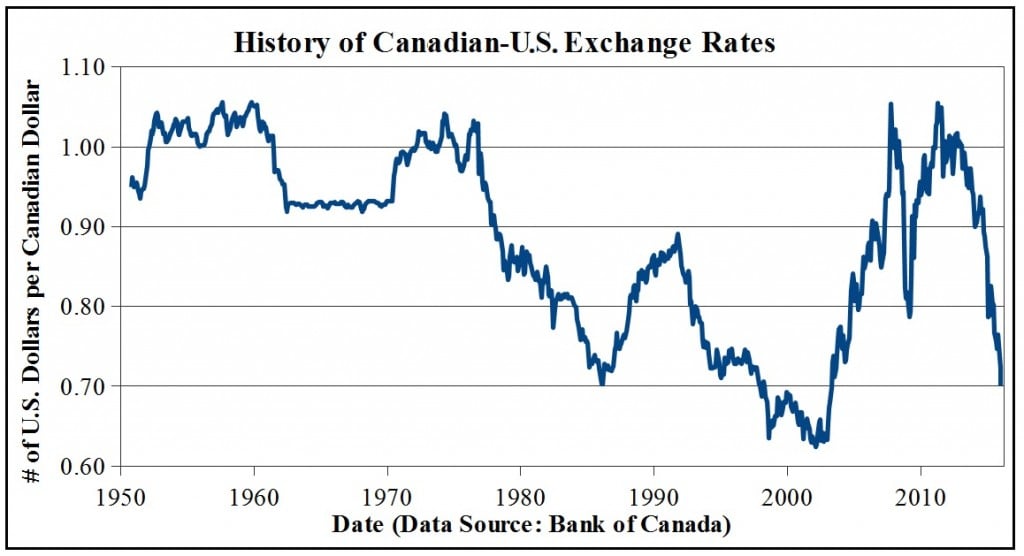What’s the deal with the Canada-U.S. exchange rate?
The history of the low loonie plus Norm Rothery's top stock picks
Advertisement
The history of the low loonie plus Norm Rothery's top stock picks
 Alas, it’s hard to say where the Canadian dollar will go from here.
But currencies tend to exhibit short-term momentum, which doesn’t bode well for the immediate future of the loonie.
Making matters worse, the Bank of Canada is expected to lower interest rates and the U.S. Federal Reserve is expected to raise rates in 2016. These changes could put further pressure on the dollar. After all, why stay in relatively riskier Canadian bonds when you can get better rates with U.S. bonds?
More positively, the OECD estimates that the Canada dollar’s purchasing power parity is near 79 U.S. cents. You’ll remember that purchasing power parity is the exchange rate at which currencies are theoretically in equilibrium. Mind you, large deviations regularly occur and can persist for long periods in practice. (While the OECD numbers tend to be fairly stable from year to year, the latest figures are from 2014 and are a little stale.)
Overall it’s shaping up to be a hard winter for Canadians and a particularly difficult one for dieters who want to load up on veggies.
Alas, it’s hard to say where the Canadian dollar will go from here.
But currencies tend to exhibit short-term momentum, which doesn’t bode well for the immediate future of the loonie.
Making matters worse, the Bank of Canada is expected to lower interest rates and the U.S. Federal Reserve is expected to raise rates in 2016. These changes could put further pressure on the dollar. After all, why stay in relatively riskier Canadian bonds when you can get better rates with U.S. bonds?
More positively, the OECD estimates that the Canada dollar’s purchasing power parity is near 79 U.S. cents. You’ll remember that purchasing power parity is the exchange rate at which currencies are theoretically in equilibrium. Mind you, large deviations regularly occur and can persist for long periods in practice. (While the OECD numbers tend to be fairly stable from year to year, the latest figures are from 2014 and are a little stale.)
Overall it’s shaping up to be a hard winter for Canadians and a particularly difficult one for dieters who want to load up on veggies.
| Name | Price | P/B | P/E | Earnings Yield | Dividend Yield |
|---|---|---|---|---|---|
| National Bank (NA) | $38.76 | 1.37 | 8.5 | 11.76% | 5.57% |
| Bank of Nova Scotia (BNS) | $54.31 | 1.33 | 9.51 | 10.51% | 5.16% |
| CIBC (CM) | $89.68 | 1.75 | 10.1 | 9.90% | 5.13% |
| Shaw (SJR.B) | $23.49 | 2.18 | 13.12 | 7.62% | 5.04% |
| TransCanada (TRP) | $42.94 | 1.8 | 18.12 | 5.52% | 4.84% |
| BCE (BCE) | $53.88 | 3.76 | 17.72 | 5.64% | 4.83% |
| TELUS (T) | $37.72 | 3.05 | 15.98 | 6.26% | 4.67% |
| Bank of Montreal (BMO) | $73.52 | 1.31 | 11.14 | 8.98% | 4.57% |
| Power Corp (POW) | $27.60 | 1.02 | 6.92 | 14.46% | 4.51% |
| Royal Bank (RY) | $70.25 | 1.78 | 10.42 | 9.59% | 4.50% |
Share this article Share on Facebook Share on Twitter Share on Linkedin Share on Reddit Share on Email